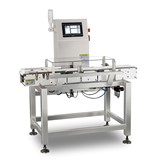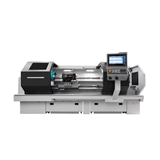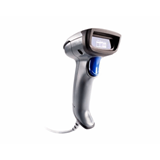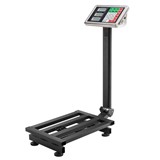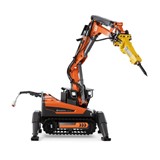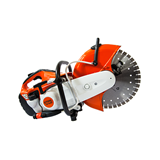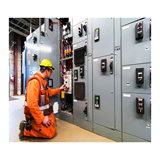Buying a demolition excavator in Australia? Compare costs, features, and certifications. Get practical advice on setup, finance options, and choosing the right model.
Key takeaways
- Demolition excavators are purpose-built for tearing down tough structures, don’t confuse them with standard diggers. Their extended reach, reinforced arms, and attachments make them demolition specialists.
- Prices start from $200,000 for mid-range models, but high-reach or ultra-heavy-duty models can exceed $700,000.
- Fuel consumption averages 15–25 litres/hour for standard models. Factor this into your ongoing costs.
- Key types include high-reach, long-front, and zero-tail swing excavators, each suits different job sites and clearance needs.
- Common attachments include hydraulic breakers, pulverisers, shears, and multi-processors.
- Finance options include chattel mortgages, equipment loans, and leasing, loan terms typically range from 3 to 7 years.
- Routine maintenance includes daily checks, hydraulic inspections, and track wear, expect annual service costs between $5,000–$10,000.
- Australian standards (AS 2550.1 and AS 1418.8) govern safe crane and lifting operations, which may apply depending on your demolition excavator’s configuration.
- Warranties vary by brand, but 2-year/2,000-hour coverage is standard with some OEMs offering up to 5 years as part of fleet deals.
- Choosing the right demolition excavator: Pick the right size and features for your job, compact for tight sites, mid-size for commercial, high-reach for tall structure, to boost efficiency and safety.
- On-site setup and transport considerations: Plan for permits, transport, site access, and assembly early, as these affect costs and schedules, especially for large or high-reach machines.
Introduction: Why demolition excavators deserve their own spotlight
Thinking about buying a demolition excavator? A great choice, if you're in construction, civil works, or large-scale site clearance, these machines are absolute beasts when it comes to heavy tearing, lifting, and crushing. But don’t fall into the trap of thinking any excavator can do the job. Demolition work demands more power, reach, and safety features than your typical dig-and-dump machine.
In this guide, we’ll break down everything you need to know, types, prices, features, upkeep, finance options, and legal stuff. Whether you're expanding your fleet or stepping into the demolition game for the first time, this is the guide you’ll want bookmarked.
What is a demolition excavator?
Put simply, a demolition excavator is an excavator customised or purpose-built for tearing down structures, especially multi-storey buildings, concrete, steel, and brickwork. They often feature:
- Reinforced booms and arms for withstanding immense stress
- High-reach capabilities (some up to 30 metres)
- Additional counterweights for stability
- Heavier undercarriages
- Operator protection systems (like falling object guards and rollover protection)
Think of them as the "wrecking balls" of the modern age, more precise, safer, and surprisingly versatile.
Types of demolition excavators
Demolition jobs vary a lot, so the right machine depends on your site layout and structure height.
High-reach demolition excavators
- Designed for tall structures
- Reach heights from 20 to 30 metres
- Require stable, flat surfaces and generous clearance
- Common in urban commercial building knockdowns
Standard demolition excavators
- Modified standard machines with attachments
- Used for mid-level or ground demolition
- Best for mixed-use projects (residential, light commercial)
Compact or zero-tail swing excavators
- Ideal for tight or urban spaces
- Limited reach but highly manoeuvrable
- Great for selective demolition jobs
Long-front excavators
- Extended reach horizontally
- Suitable for controlled knockdowns near live infrastructure
What do demolition excavators cost in Australia?
Prices vary depending on the size, reach, and type of machine you’re after:
- Compact demolition excavators (8–15 tonnes) generally start from around $150,000 and can go up to $250,000. These are ideal for residential or tight-access jobs.
- Mid-range excavators (20–35 tonnes) are more versatile and suited to commercial projects, with price tags typically between $250,000 and $450,000.
- High-reach models (30 metres and above) are purpose-built for bringing down multi-storey structures and usually range from $500,000 to $750,000 or more, depending on brand and features.
- Used machines, especially those around 5–10 years old, can be picked up for $100,000 to $300,000, but you’ll want to factor in condition, service history, and hours on the clock.
Tip: These prices don’t include attachments, which can easily add another $30,000 to $100,000 to your total investment, depending on the tools you need.
Common attachments used in demolition
Demolition isn’t just about brute strength, it’s about the right tool for the right material. Here’s what you’ll likely need:
- Hydraulic breakers: Smash through concrete and rock
- Concrete pulverisers: Crush rubble into reusable fill
- Shears: Slice steel beams, pipes, and rebar
- Multi-processors: Combo tools that cut, crush, and shear
- Buckets: For material removal and clean-up
Operating and safety features
You can’t afford mistakes on demolition sites. Demolition excavators often come with:
- FOPS and ROPS cabins to protect the operator
- 360-degree cameras and proximity sensors
- Auto-lube systems for reduced wear and tear
- Anti-drop valves and load-holding check valves
- Variable gauge undercarriages for better balance on uneven terrain
Maintenance and servicing costs
Your demolition excavator takes a beating, so keeping it in top shape isn’t optional. Here’s a rough guide to what you’re in for:
Daily maintenance
- Greasing joints and checking hydraulic lines
- Inspecting tracks and undercarriage
- Checking coolant and oil levels
Quarterly or annual servicing
- Hydraulic fluid replacement
- Engine diagnostics
- Track and idler inspections
- Filter and seal replacements
Average annual maintenance costs: $5,000–$10,000 (excluding breakdowns or major part replacements)
Parts availability in Australia
Common parts buyers often replace:
- Hydraulic hoses and seals
- Teeth and buckets
- Undercarriage parts (rollers, sprockets, tracks)
- Filters and belts
Tip: Always check local dealer support and availability before buying a specific brand or model.
Finance options for demolition excavators
Let’s be real, dropping half a million dollars on a demolition excavator outright just isn’t realistic for most businesses. And honestly, it usually doesn’t make financial sense either.
That’s why most Australian contractors turn to equipment finance. It allows you to preserve working capital, spread repayments over time, and take advantage of tax deductions.
Here’s a breakdown of the most common options used for heavy equipment like demolition excavators:
Chattel mortgage
This is one of the most popular options for machinery buyers in construction and civil works.
- You own the machine outright from day one
- Can claim GST upfront, depreciation, and interest as tax deductions
- Suits buyers with good cash flow who want asset control
- The excavator acts as security on the loan
Finance lease
More flexible for businesses who want to keep upfront costs low.
- Monthly payments are typically fully tax-deductible
- No upfront payment required
- Option to purchase the excavator at lease-end for a residual amount
- Good if you're unsure whether to keep the asset long term
Hire purchase
A blend of ownership and flexibility.
- You take ownership after the final payment
- Fixed payments make budgeting easier
- Still allows for some tax benefits
- Works well for buyers planning to keep the machine for years
Typical finance terms in Australia
- Loan terms: Usually 3 to 7 years
- Interest rates (as of mid-2025): Range from 6%–9%, depending on your credit history, lender, and asset type
- Deposits: Some lenders may require 10%–20% down, though low-doc loans are available
Whether you're investing in new or used machinery, working with a specialist broker who understands heavy equipment can save you time, hassle, and money. Many Australian buyers turn to platforms like EasyAsset, where you can compare finance options from trusted lenders and get tailored support every step of the way.
Compliance and certifications in Australia
Let’s be clear, buying a demolition excavator isn’t just about specs and attachments. It’s also about making sure you’re 100% compliant with Australian laws and safety standards. Skipping this step can lead to serious fines, site shutdowns, or worse, injury or liability.
Key standards that may apply
Depending on how your demolition excavator is used, different Australian Standards could come into play:
- AS 2550.1 & AS 1418.8 – Cranes, hoists, and lifting gear
- These cover safe lifting operations, especially if your excavator is used for lifting heavy structural elements (like concrete slabs or beams).
- AS 4970 – Protection of trees on development sites
- If you're demolishing near protected flora, your works must minimise root and canopy disturbance.
- AS/NZS ISO 12100 – Machinery safety principles
- This broader standard ensures your machine is safe by design, important when importing lesser-known or second-hand models.
- Safe Work Australia demolition code of practice
- These national guidelines cover everything from dust suppression to risk assessments and operator safety.
Licensing and operator requirements
Operating demolition machinery isn’t just plug-and-play. You’ll need to make sure your people and plant are legally ready to go.
- High-risk work licence (HRW):
- Required for major demolition projects, especially those involving structural steel or multi-storey buildings. Check with your local work health authority.
- Plant registration:
- In some states (like NSW and VIC), certain types of heavy plant must be registered before being used on worksites.
- Verification of competency (VOC):
- Many tier-one contractors and government sites will demand a VOC assessment for any operator, especially if using high-reach gear or hydraulic attachments.
Choosing the right demolition excavator for your project
Not all demolition jobs are created equal, and neither are the machines that do them. Choosing the right excavator isn’t just about budget or brand; it’s about matching the machine to your typical project environment, materials, and limitations. Get this right and you’ll save time, reduce wear, and improve safety. Get it wrong, and you could be dealing with costly inefficiencies or equipment that simply can’t do the job.
Here’s a quick breakdown to help guide your decision:
- Urban sites or tight access?
- Go for a compact or zero-tail swing model (8–20 tonnes). These are agile, easier to transport, and ideal for navigating close quarters without damaging surrounding structures.
- Mid-size commercial knockdowns?
- A 20–35 tonne machine with a quick coupler system will let you swap between shears, breakers, and buckets without downtime. Look for a solid mix of power and flexibility.
- Multi-storey demolition or high-clearance jobs?
- You’ll need a high-reach excavator with a boom extension of 20–30 metres, dust suppression, and advanced operator protection. Make sure your site can accommodate the larger footprint and setup needs.
- Heavy industrial work?
- Choose reinforced, heavy-duty machines with upgraded undercarriages and hydraulic capacity to handle steel, concrete, and hard fill. These typically start around 35 tonnes and up.
- Multi-purpose use across different projects?
- Invest in a machine with hydraulic quick-hitch systems and attachment compatibility that adds flexibility to adapt between demolition, digging, and material handling.
Still unsure? Speak with a dealer about your most common job types, they’ll often recommend a configuration based on what similar contractors are using in your area.
On-site setup and transport considerations
Buying the machine is one thing, getting it to site and ready to work is another entirely. Demolition excavators are big, heavy, and often require special logistics and preparation, especially for high-reach units or metro job sites. Here's what you need to plan for:
Transporting the machine
- Float or tilt tray hire: Depending on your machine's size, expect to pay anywhere from $1,500 to $5,000 for transport within your state. Longer distances or oversize loads will cost more.
- Oversize load permits: Machines over a certain width (often 2.5m) or weight require permits under National Heavy Vehicle Regulator (NHVR) rules. These permits vary by state and job route.
- Escort vehicles and restrictions: Oversize transport might need traffic escorts or be restricted to certain hours (e.g. outside peak times in Sydney or Melbourne).
- Access routes: Check site entrances, gate widths, overhead wires, and gradient. You’d be surprised how many jobs get delayed because the machine physically can't get in.
On-site setup and prep
- Machine assembly time: Some high-reach excavators are delivered in pieces and need on-site reassembly with a crane. Factor in up to a full day for setup depending on model.
- Ground preparation: Soft or unstable ground may need compacting or crane mats to safely support the machine’s weight and stability.
- Counterweights: Many high-reach models require removable counterweights for transport. These must be reinstalled and torqued correctly on-site.
- Pre-start checks: Always allow time for operator inspections, hydraulic checks, and software calibration before swinging into action.
Frequently asked questions
Q: Can I use a standard excavator for demolition?
Technically, yes, but it’s risky and inefficient. Standard machines aren't built for the strain, reach, or attachments that demolition jobs need.
Q: How long does a demolition excavator last?
With proper servicing, you can get 10–15 years of solid work, more if the machine’s not used daily.
Q: Should I buy new or used?
New = peace of mind + warranty + latest safety features. Used = lower upfront cost but more maintenance risk. Consider how long you’ll use it.
Q: What size excavator is best for inner-city demolition?
Compact or zero-tail swing units (15–20t) are best. They’re nimble, safer around infrastructure, and often compliant with local council access restrictions.
Conclusion: Smash your next project with the right machine
Demolition excavators are serious investments, but also serious time-savers when chosen right. Whether you need high-reach height for inner-city tower takedowns or a compact model for residential jobs, there’s a machine for every purpose and budget.
Just remember, match your excavator to your typical job site, factor in attachments, think long-term on maintenance, and make sure you stay compliant.



-160x160-state_article-rel-cat.png)

